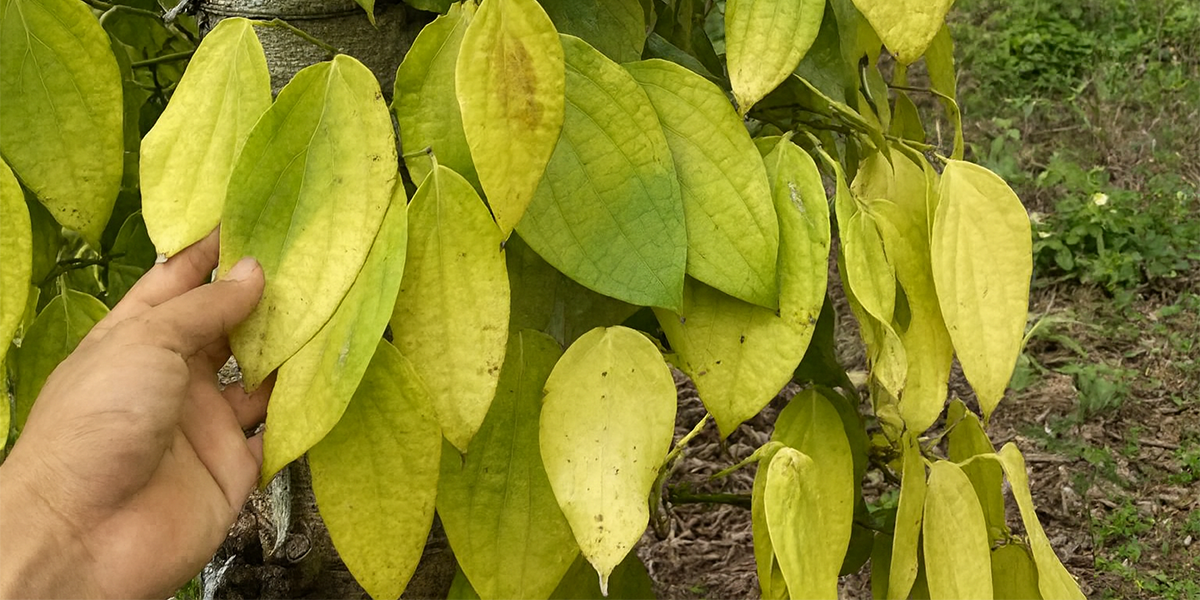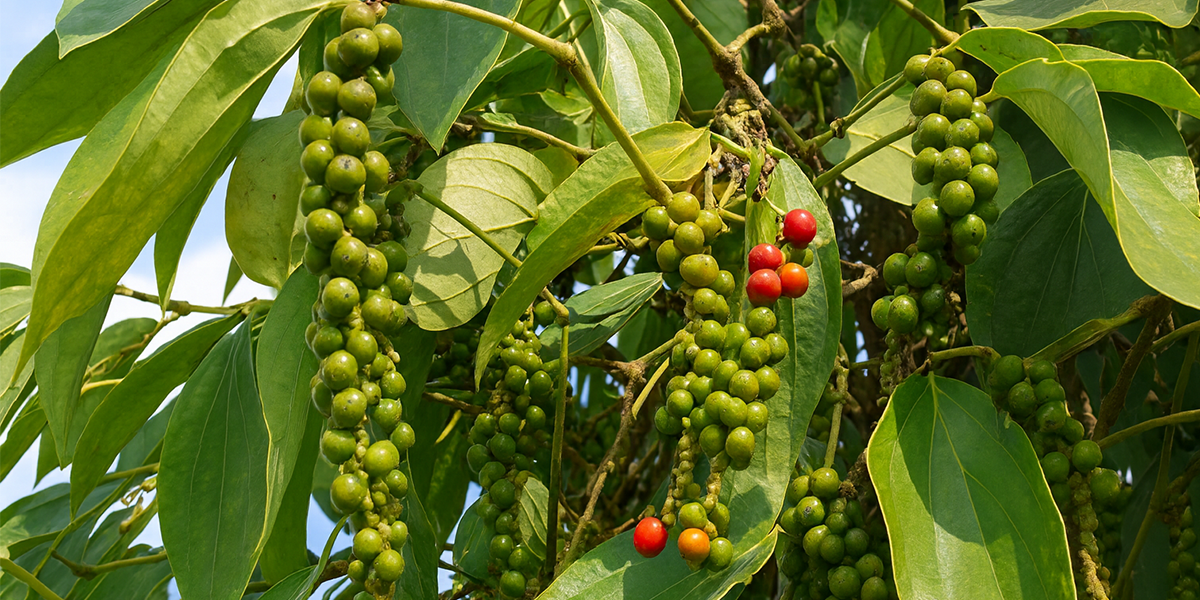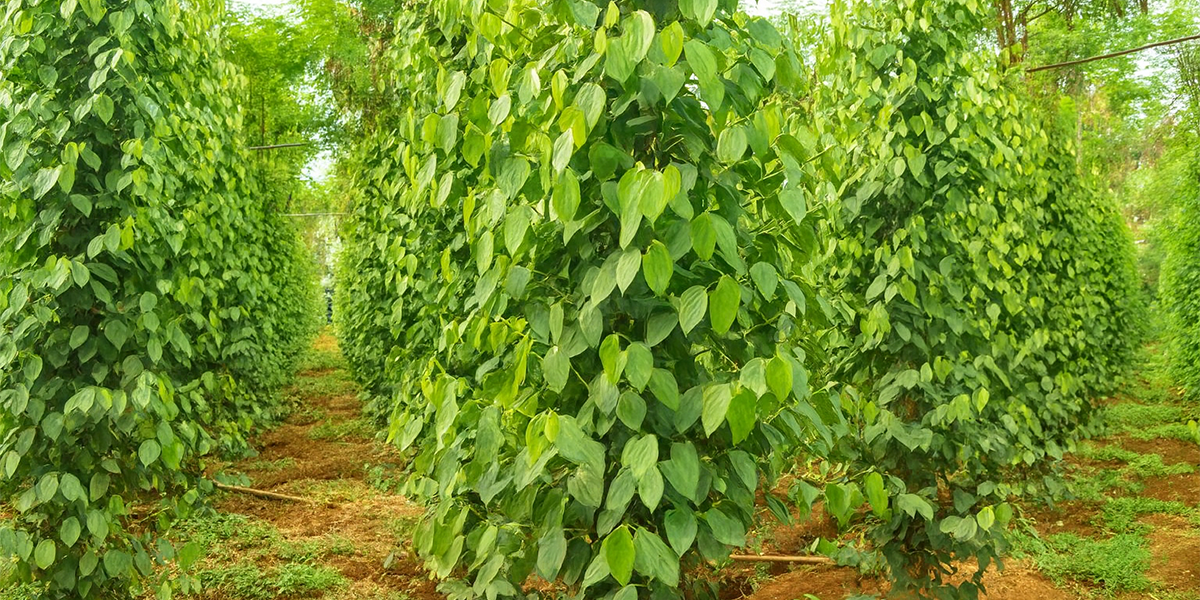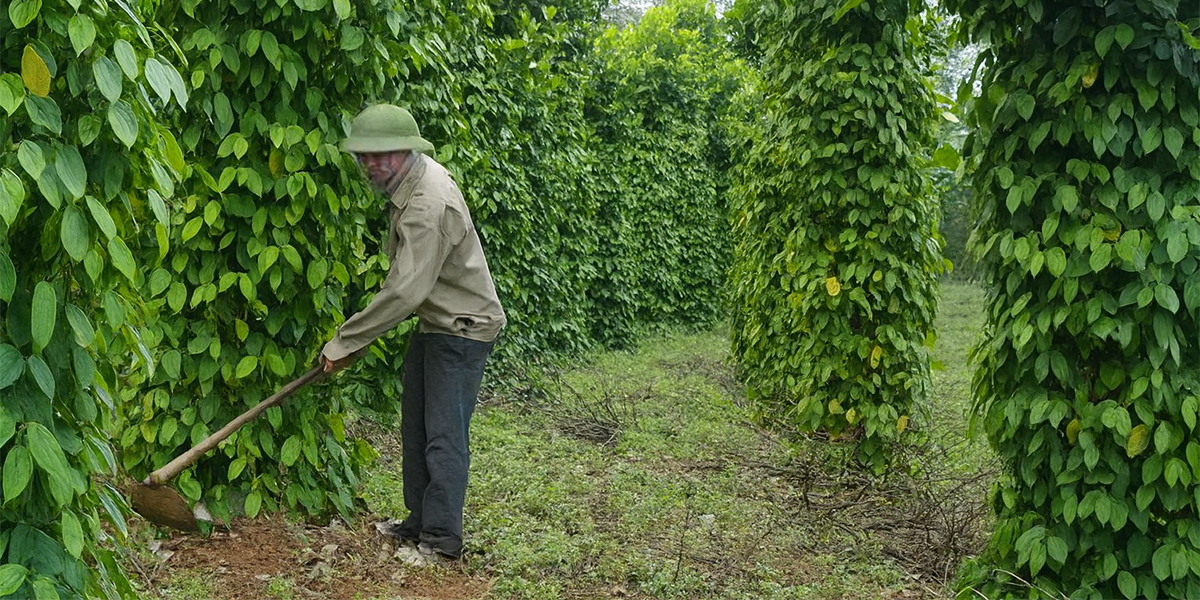YELLOWING LEAVES AND VINE DIEBACK AT THE END OF THE RAINY SEASON - WHAT CAN YOU DO TO SAVE YOUR CROP?
21 Oct 2025

Why does leaf yellowing and vine dieback in pepper plants often break out strongly at the end of the rainy season, and what are the most effective measures to control this disease?
Characteristics and causes of leaf yellowing and vine dieback in pepper plants
Time of occurrence and identifiable symptoms
Leaf yellowing and vine dieback in pepper plants (caused by soil-borne fungi) commonly appear at the end of the rainy season, when soil remains waterlogged and drainage is poor. At first, pepper leaves turn yellow and droop, vines gradually wilt, and roots rot-losing their ability to absorb nutrients. If not treated promptly, the disease can spread rapidly, causing the entire pepper pole to die.
The main pathogens are groups of soil fungi that penetrate through roots, stems, or leaves, causing tissue rot, blockage of vascular systems, and eventual plant death. Prolonged rainfall and high soil humidity provide ideal conditions for fungal growth and disease spread through irrigation water or contaminated soil.

Leaf yellowing disease on pepper plants. Photo: Internet
Effective measures to control diseases in pepper plants
To effectively manage fungal diseases in pepper plants, farmers should apply integrated control methods that combine proactive prevention with the appropriate use of fungicides, ensuring safety and sustainability for their pepper gardens.
Improve garden conditions - Ensure proper drainage
At the end of the rainy season, farmers should dig drainage trenches around pepper poles to prevent waterlogging. Prolonged soil moisture creates a favorable environment for fungal growth. In low-lying areas, it is advisable to raise planting beds and cover the base of the vines with straw or dry leaves to reduce sudden moisture evaporation.
Enrich the soil with organic fertilizers and biological products
After the rainy season, soil nutrients are often leached out, and the microbial balance is disturbed. Farmers should apply well-decomposed organic fertilizers combined with biological products to restore beneficial microorganisms that help suppress pathogens. This is a key step in ensuring a sustainable disease management strategy for pepper plants.
Provide sufficient NPK fertilizers to support recovery
During this stage, pepper plants are channeling energy into fruit development and new shoot growth for the next season, so they require adequate nutrients. Farmers are advised to use balanced fertilizers such as:
- NPK CON CÒ 17-7-17+0.15Zn+0.1B: Helps plants recover after disease and enhances resistance.
- NPK CON CÒ 17-17-17+4S+0.1Zn+0.03B: Promotes uniform growth of stems, leaves, and fruits.
Additionally, foliar fertilizers can be applied to quickly supplement nutrients, keeping the pepper plants green, strong, and resilient.

Pepper plants after being adequately nourished. Photo: Internet
Recommended fungicides
When signs of fungal infection appear on pepper plants, it is necessary to treat them immediately with suitable fungicides and alternate active ingredients to avoid resistance.
Active ingredients: Azoxystrobin 20% + Dimethomorph 20%
- Dual-action active ingredients with strong systemic and translaminar effects.
- Effectively prevent and treat soil-borne fungal diseases, especially leaf yellowing and vine dieback.
- Protect the root system, helping pepper plants maintain stable growth.
Active ingredient: Mancozeb 80WP
- Broad-spectrum contact fungicide that prevents fungal development in high-humidity conditions.
- Commonly combined with other active ingredients to increase effectiveness and limit disease spread on stems and leaves.
- Keeps pepper gardens safe during prolonged rainy and humid periods.
Active ingredients: Tricyclazole + Hexaconazole
- Effectively control fungal diseases on stems and leaves of pepper plants.
- Help maintain green foliage, enhance photosynthesis, and promote quick recovery after rain.
- Support the development of new shoots for the next growing season.

Pepper garden grows lush and healthy when properly cared for. Photo: Internet
Nutritional supplementation for pepper plants - The foundation for strong and disease-resistant growth
One of the most sustainable ways to prevent diseases in pepper plants is by maintaining their overall health through a balanced nutrition regime. When the plant is strong, with healthy roots, thick tissues, and green leaves, fungal pathogens find it much harder to attack.
Farmers are encouraged to prioritize high-quality organic fertilizers such as ORGANICONCO or ANIMA to improve soil structure, increase aeration, and enhance moisture retention. Combining these with CON CÒ NPK fertilizer helps pepper plants develop evenly and recover quickly after disease.
In addition, regularly spraying foliar fertilizers such as COFOLI AMINO, COFOLI K300 or SUPERTAN ĐỎ every 7-10 days during the rainy season helps plants absorb nutrients rapidly and boosts their resistance to fungal infections.

Image of farmers tending to pepper plants. Photo: Internet
Proactive disease prevention - Protecting pepper gardens before the dry season
The end of the rainy season marks a critical turning point for the health of pepper gardens before entering the dry period. Early disease prevention not only helps farmers protect their crops but also ensures the plants have enough strength to nourish large, evenly ripened fruits and maintain stable growth for the next season.
To achieve this, farmers should implement a comprehensive management plan, including:
- Improving drainage and keeping the garden well-ventilated.
- Applying organic and biological fertilizers to enhance soil resistance.
- Rotating fungicides according to proper technical guidance.
- Providing balanced nutrition to help pepper plants recover and stay healthy.
Conclusion
Diseases on pepper plants not only reduce yield but also shorten the lifespan of the garden if not treated promptly. Applying proper disease control measures on pepper plants, combining effective fungicides and balanced nutrition, will help farmers protect their pepper gardens efficiently and ensure sustainable development through many growing seasons.
Views
268
